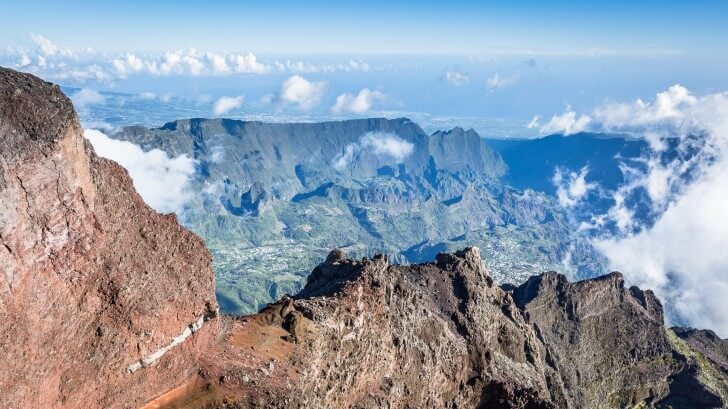BBC Earth newsletter
BBC Earth delivered direct to your inbox
Sign up to receive news, updates and exclusives from BBC Earth and related content from BBC Studios by email.
Landscapes
Five million years ago, deep in the middle of the Indian Ocean, two underwater volcanoes started to erupt on the seafloor.
Over the next 3 million years they eventually grew tall enough to emerge from the ocean floor over 4000m above.
They grew so large that one of them now stands at 3069m above sea level; its total height from the seafloor is almost as tall as Everest.

This is the roof of the Indian Ocean, Piton des Neiges, the tallest mountain around offering spectacular views over the Indian Ocean. It’s neighbour, Piton de la Fournaise, is one of the most active volcanoes in the world, the latest eruption started on April 28, 2018 and at the time of publishing continues today. Together these two volcanoes form the French island of Réunion.
The volcanoes are central to this island’s existence and to the people that live there. Réunion is a small tropical island, measuring only 69km (43 miles) at its widest. This small area holds rare endemic species, spectacular rainforest covered mountainous landscapes, rumbling volcanoes, vibrant coral reefs and a unique culture in tune with each other and the natural world.

Most of us know Indian Ocean islands for their tropical paradise holiday destinations - Mauritius, the Maldives, Réunion Island - but these islands and a number of lesser-known neighbouring islands are all related in an unexpected way. They were all created by the Réunion volcanic hotspot.
We associate most volcanoes with tectonic plate boundaries, but there are some that erupt in more unusual places. Like Hawaii and Yellowstone, they are associated with hotter parts of the mantle, sometimes in the middle of tectonic plates and they can create chains of volcanoes.

The Réunion hotspot is thought to have been active for at least 66 million years, causing eruptions that relate to the extinction of the dinosaurs and more recently over the last 10 million years creating the Mascarene Islands, including Mauritius and Réunion.
It’s a rare geological setting when such large volcanoes grow from the seafloor to such great heights in the middle of tectonic plate - nature’s mightiest creating an island where plants can take hold and then animals start to find the island. As it grows weather systems form and rivers carve themselves through the young volcanic rock.

The island was settled in the 17th century, initially by the Portuguese, followed by the French, who still govern it today making it the outermost region of the EU. However, there are a number of cultures from Africa and Asia that live in harmony and have created their own Creole island identity. The population has been rapidly rising with over 800,000 people calling this small island their home.
The unique evolution of the island means there are many endemic plants including orchids and rare birds with the iconic endemic tree fern making the jungle look like a real life Jurassic park. The increase in population has put pressure on the wildlife and ecosystems with a number of species that were endemic to the island already lost. A national park was created on the island in 2007 with a core mission to safeguard the island's endemic species and in 2010 it became a UNESCO World Heritage site in recognition of its rare and unique character.

To most of us the idea of living on an isolated volcano is alien, but for the people of Réunion, volcanoes are part of their everyday life, defining their culture and influencing everything from music to farming to religion. Volcanoes provide fertile soil and so much of the lowland landscape in Réunion is dominated by sugar cane plantations blowing in the wind. The sugar cane is used to make rum which is infused with locally grown spices and is a regular tipple in any bar or restaurant.

Volcanic islands provide geology in its most raw form and the people living there offer a window into a world and culture at one with nature’s rhythms. We can’t control volcanoes so if you want to live on one, you have to get used to nature’s unpredictability.
Featured image © Vivien Cumming